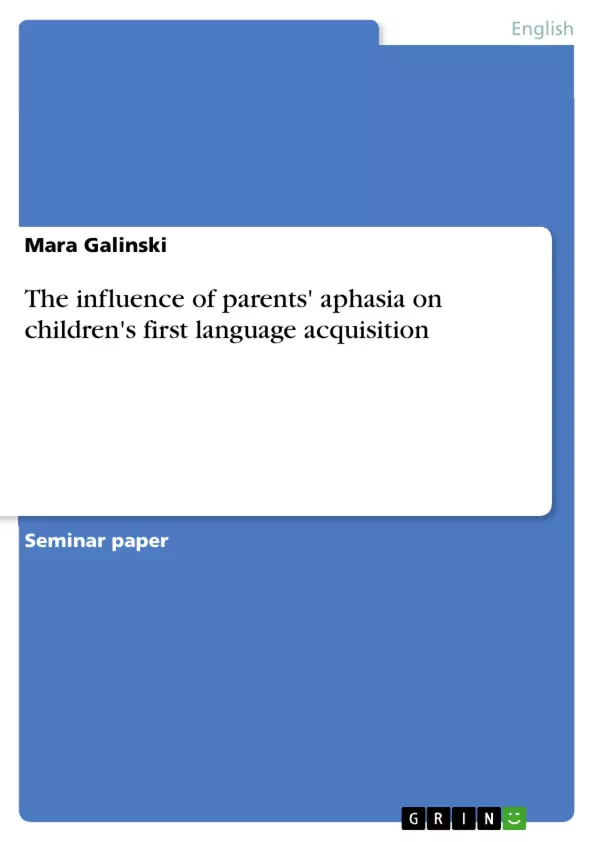What happens if parents suffer from aphasia? Will their children's first language acquisition be influenced? The following terms paper shall probe into these questions.
People suffering from the language disorder aphasia have difficulties in understanding and uttering language. They produce inappropriate or distorted words and cannot accept summons. Through this, communication with other human beings becomes problematic.
The appearances of aphasia are very different: often the disease is that distinctive that aphasics cannot produce speech voluntarily or, on the other hand, they need more time to find the words they are searching for. Jakobson claims that, as aphasia is an impairment of language, a competent linguistic examination of what in the pa-tient’s language is impaired is needed for making an exact diagnosis. Concerning Roch Lecours and Lhermitte, Jakobson is not only the one who has given neurolinguistic research an enormous impetus, but also suggests one of the first linguistic theories of aphasia. Due to that, this paper will first mainly focus on Jakobson’s linguistic theory based on clinical case studies conducted by Goldstein. For a better and clearer understanding I decided to differentiate two types of aphasia concerning Jakobson, namely similarity disorder and contiguity disorder, which both include different aspects or rather subtypes.
Inhaltsverzeichnis (Table of Contents)
- 1. Introduction
- 2. Aphasia concerning Jakobson
- 2.1. Similarity disorder
- 2.2. Contiguity disorder
- 3. Children's first language acquisition
- 4. Influence of parent's aphasia on children's first language acquisition
Zielsetzung und Themenschwerpunkte (Objectives and Key Themes)
This term paper explores the potential influence of parents' aphasia on children's first language acquisition. The paper first delves into the concept of aphasia, particularly as described by Jakobson, focusing on the distinctions between similarity and contiguity disorders. It then provides a brief overview of typical children's first language acquisition before analyzing the potential impact of parental aphasia on this process.
- Aphasia as a language disorder and its impact on communication
- Jakobson's theory of aphasia, focusing on similarity and contiguity disorders
- The stages and processes involved in children's first language acquisition
- The potential influence of parents' aphasia on children's language development
Zusammenfassung der Kapitel (Chapter Summaries)
- Chapter 1: Introduction This chapter introduces the topic of the paper by highlighting the importance of language in infants' social development. It then raises the question of how parents' aphasia might impact children's first language acquisition.
- Chapter 2: Aphasia concerning Jakobson This chapter provides a detailed overview of aphasia, focusing on Jakobson's theory of the disorder. It explains the distinction between similarity and contiguity disorders, which are rooted in different impairments of linguistic processes.
Schlüsselwörter (Keywords)
This paper centers on the key concepts of aphasia, Jakobson's linguistic theory, first language acquisition, and the potential influence of parents' aphasia on children's language development. It explores the differences between similarity and contiguity disorders in aphasia and investigates how these might affect the process of language learning in children.
- Quote paper
- Mara Galinski (Author), 2017, The influence of parents' aphasia on children's first language acquisition, Munich, GRIN Verlag, https://www.grin.com/document/456985



